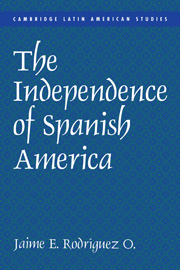Introduction
Published online by Cambridge University Press: 05 October 2013
Summary
The independence of Spanish America can best be understood as part of the larger process of change that occurred in the Atlantic world in the second half of the eighteenth and the early nineteenth centuries. This period has been called the Age of Democratic Revolutions because during that time some monarchical societies were transformed into democratic ones. That is, subjects of monarchies became citizens of nation-states. Although scholars have studied that process for the United States and France, the Spanish world has not been examined from that perspective. Most historians end the period of democratic revolutions in 1799, when Napoleon Bonaparte seized control of France. The political revolutions of the Spanish world, or Spanish Monarchy, as it was called, however, occurred after 1808. Moreover, the independence of Spanish America did not constitute an anticolonial movement, as many assert, but formed part of both the revolution within the Spanish world and the dissolution of the Spanish Monarchy. Indeed, Spain was one of the new nations that emerged from the breakup of that worldwide polity.
The American continent underwent significant transformations in the wake of the Seven Years' War (1756–1763) when both the Spanish and British crowns reordered their possessions in America, a process known in the Spanish world as the Bourbon reforms. Although both Spanish and Anglo Americans objected to many of these changes, the Spanish kingdoms in the New World did not imitate their northern brethren in rebelling against the Crown.
- Type
- Chapter
- Information
- The Independence of Spanish America , pp. 1 - 6Publisher: Cambridge University PressPrint publication year: 1998

